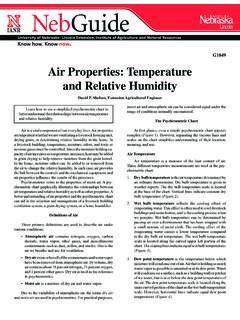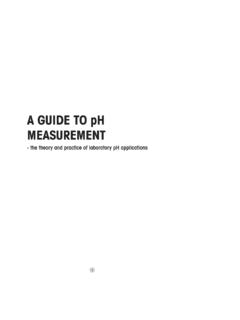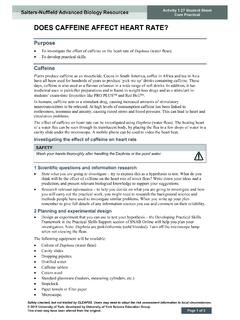Transcription of Core practical 1: Investigate a factor affecting the initial rate …
1 EDEXCEL Biology B Teacher Resource Pack 1 Pearson Education Ltd 2015 This document may have been altered from the original 1 Core practical 1 Teacher sheet Investigate a factor affecting the initial rate of reaction All users will need to review the risk assessment information and may need to adapt it to local circumstances. Core practical 1: Investigate a factor affecting the initial rate of reaction Objectives To be able to measure the initial rate of enzyme activity To understand why measuring the initial rate is important Safety Specification links Trypsin solution at concentrations of 1% or above is an irritant. It may cause an allergic reaction in those allergic to products such as washing powder.
2 Wash splashes from the skin as quickly as possible. Wear eye protection. practical techniques 1, 2, 3, 6 (and 12 if a datalogger is used) CPAC 1a, 2a, 2b, 3a 3c, 4a, 4b, 5a Procedure Notes on procedure Milk protein (casein) is broken down by protease enzymes such as trypsin. The opaque white colour of the milk is replaced by a clear solution. Light passes more easily through the final solution, so the reaction can be monitored using a colorimeter or light sensor. 1. Plan how you will dilute the 1% trypsin stock solution with distilled water to produce additional test solutions of , , and Aim to produce 10 cm3 of each concentration. Once checked, make up the solutions as planned.
3 2. Place 2 cm3 of trypsin solution and 2 cm3 of distilled water into a cuvette. Use this as a reference cuvette to set the colorimeter absorbance to zero. 3. Measure 2 cm3 of milk suspension into a second cuvette. 4. Add 2 cm3 of trypsin solution to the milk in the cuvette. Working quickly, mix and place the solution into the colorimeter and start the stop clock. 5. Measure absorbance immediately and then at 15 second intervals (or more frequently if recording electronically) for 5 minutes, or until there is little change in absorbance. 6. Rinse the cuvette with distilled water and repeat for each concentration. A check should be done before the lesson to ensure that the milk powder suspension provides an absorbance value within a suitable range when first mixed with the enzyme.
4 Further dilution of the milk may be required, depending on the brand used. Note that absorbance does not have true units, although changes in absorbance units may be discussed. Watch that students do not contaminate the stock milk suspension with trypsin as they are transferring solutions to the cuvettes. To get repeat measurements when colorimeters are limited, each group can make up one set of concentrations and then pool class results before calculating mean values to use in the absorbance/time graphs. Inexpensive simple colorimeters can be constructed using a light-emitting diode (LED), a light-dependent resistor (LDR), a suitable resistor and an ammeter. Various designs can be found using an Internet search.
5 EDEXCEL Biology B Teacher Resource Pack 1 Pearson Education Ltd 2015 This document may have been altered from the original 2 Core practical 1 Teacher sheet Investigate a factor affecting the initial rate of reaction All users will need to review the risk assessment information and may need to adapt it to local circumstances. Answers to questions 1. Independent: trypsin concentration. Dependent: rate of reaction in absorbance units, s 1. 2. Because the reaction is rapid and the milk (substrate) concentration quickly declines. The rate slows as the substrate is used up. Comparisons can only be made at the start of the reaction where controlled variables such as substrate concentration are the same for all levels of the independent variable.
6 3. A systematic error, because it would cause absorbance readings to be higher than the true value for every measurement . 4. pH the rate of reaction of enzymes varies with pH, due to changes in the shape of the active site. An enzyme would have the highest rate of reaction at its optimum pH. A buffer might be used to maintain pH at a suitable level. Temperature the rate of reaction of enzymes varies with temperature. As temperature increases, particles gain more energy and more collisions take place between enzyme and substrate particles. Enzymes have an optimum temperature at which the rate of reaction is at its peak. Above that temperature, enzymes will begin to denature, changing the shape of the active site and preventing further catalysis.
7 A water bath and thermometer could be used to maintain a suitable temperature. Sample data Absorbance/absorbance units Trypsin concentration (%) 0 s 15 s 30 s 45 s 60 s 75 s 90 s EDEXCEL Biology B Teacher Resource Pack 1 Pearson Education Ltd 2015 This document may have been altered from the original 1 Core practical 1 Student sheet Investigate a factor affecting the initial rate of reaction practical activities have been safety checked but not trialled by CLEAPSS.
8 Users may need to adapt the risk assessment information to local circumstances. Core practical 1: Investigate a factor affecting the initial rate of reaction Objectives To be able to measure the initial rate of enzyme activity To understand why measuring the initial rate is important Safety All the maths you need Trypsin solution at concentrations of 1% or above is an irritant. It may cause an allergic reaction in those allergic to products such as washing powder. Wash splashes of trypsin from the skin as quickly as possible. Wear eye protection. Inform the teacher if any trypsin gets into your eyes. Recognise and make use of appropriate units in calculations.
9 Use an appropriate number of significant figures. Construct and interpret frequency tables and diagrams, bar charts and histograms. Translate information between graphical, numerical and algebraic forms. Plot two variables from experimental or other data. Calculate rate of change from a graph showing a linear relationship. Draw and use the slope of a tangent to a curve as a measure of rate of change. Equipment skimmed milk powder suspension (2%) standard protease (trypsin) solution (1%) IRRITANT 6 test tubes and holder stop clock two 5 cm3 pipettes (or syringes/measuring cylinders) eye protection access to colorimeter (see diagram) (or light meter with datalogger) 2 cuvettes distilled water Diagram fig A A simple colorimeter.
10 EDEXCEL Biology B Teacher Resource Pack 1 Pearson Education Ltd 2015 This document may have been altered from the original 2 Core practical 1 Student sheet Investigate a factor affecting the initial rate of reaction practical activities have been safety checked but not trialled by CLEAPSS. Users may need to adapt the risk assessment information to local circumstances. Procedure Milk protein (casein) is broken down by protease enzymes such as trypsin. The opaque white colour of the milk is replaced by a clear solution. Light passes more easily through the final solution and so the reaction can be monitored using a colorimeter (see diagram) or light sensor. 1. Plan how you will dilute the 1% trypsin stock solution with distilled water to produce additional test solutions of , , and Aim to produce 10 cm3 of each concentration.















